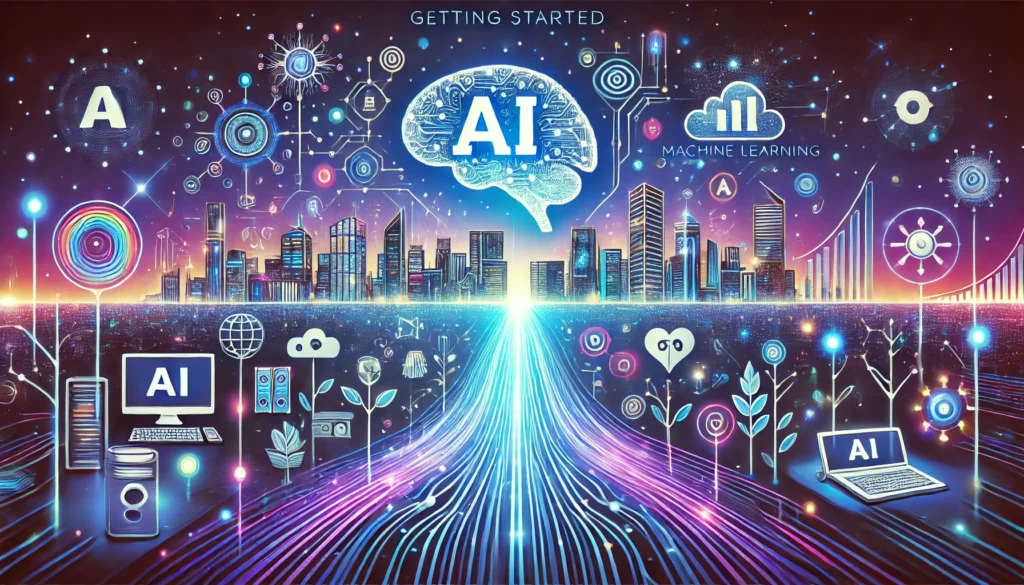Tips for Getting Started in AI and ML – Artificial Intelligence (AI) and Machine Learning (ML) are transforming industries, creating new career paths, and sparking innovative solutions. If you’re like me—excited about the possibilities but unsure where to start—this guide will help you navigate the foundational steps into this fascinating world. This post shares my learnings, resources, and strategies as I begin my journey into AI and ML. By the end, you’ll have a roadmap to kickstart your own path.
1. Start With a Solid Foundation: Learning Python
Python is the most recommended language for AI and ML because of its simplicity and powerful libraries. I’m currently learning Python through Coursera’s Python for Everybody (https://www.coursera.org/learn/python) Course, a beginner-friendly course that covers essential programming concepts like:
- Variables, data types, and control structures.
- Functions and modular programming.
- Understanding the foundations and basics of programming
Why Python First?
You’ll need Python to access the ML libraries and frameworks (like TensorFlow). Start small, build confidence, and practice daily to solidify your skills. I’ve been personally coding in well over 20+ languages and for the most part its a lot easier for me coming from a development background. That being said there is still a lot to learn and take in and I recommend you focus on daily exercises and training in Python as you will begin using this coding language for most of your work.
2. Dive Into AI and ML Courses
Once you’re comfortable with Python, it’s time to explore AI and ML. Here’s a breakdown of the courses I’m taking:
- Generative AI for Beginners (Udemy)
- Ideal for newcomers.
- Covers AI fundamentals and introduces tools like ChatGPT.
- This was a pretty good overview of much of the theory and concepts in AI and it’s definitely one you want to start with before getting into the other ones.
- Deep Learning (Udemy)
- Learn the concepts of neural networks and backpropagation.
- Work with frameworks like TensorFlow and PyTorch.
- Data Science and Machine Learning With Python (Udemy)
- Combines data science principles with practical ML techniques.
- Learn data preprocessing, model building, and evaluation.
- Artificial Intelligence A-Z (Udemy)
- Comprehensive AI overview with real-world applications.
- Perfect for understanding how AI fits into industries.
- Machine Learning (Udemy)
- Focuses on supervised and unsupervised learning.
- Learn to build predictive models and uncover insights.
Pro Tip: Take notes, participate in projects, and complete the assignments in each course. Hands-on practice is the key to mastering these skills.
3. Build Projects and Showcase Your Skills
Theoretical knowledge is important, but practical experience is what truly matters. Start small and work on projects
- Setup GIT: Create a GIT account and start working on public AI projects like Llama and several others
- Learn GIT: If you’re new to GIT I recommend learning about the basics of GIT (I even taught a Udemy course on it here => https://www.udemy.com/course/learn-git-fast/)
- Generative AI: Experiment with tools like ChatGPT API to create text-based applications.
As you gain confidence, contribute to open-source projects or build your own portfolio. Use Git to document your work and make it accessible to potential employers.
4. Join Communities and Stay Updated
AI and ML evolve rapidly, so staying connected to the community is vital. Here’s how:
- Forums: Engage in platforms like Reddit (e.g., r/MachineLearning) and other forums.
- Discord Servers and Social Media: Engage in social media like X/Twitter and servers like Discord
- LinkedIn: Follow AI thought leaders and share your progress. Follow me on LinkedIn as well – https://www.linkedin.com/in/mrmetaverseamerica/
- Newsletters: Subscribe to AI newsletters for updates on trends and tools. (Please join mine as well)
Networking opens doors to collaborations, mentorships, and job opportunities.
5. Future Plans and Scaling Up
Once I complete these foundational courses, I plan to:
- Dive deeper into specialized areas like Natural Language Processing (NLP) and Computer Vision.
- Learn advanced frameworks like PyTorch for custom model development.
- Learn more on how to automate the various parts of my own life
- Integrate these technologies into Chaarmi Worlds
- Work in the industry to get my feet wet into the real-world usage of AI and ML in day-to-day business and life (Not just the theory)
I hope this blog post was useful for all of you. I truly hope you can join me on this incredible journey entering the exciting world of Artificial Intelligence and Machine Learning!
